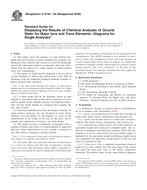Potrebujeme váš súhlas na využitie jednotlivých dát, aby sa vám okrem iného mohli ukazovať informácie týkajúce sa vašich záujmov. Súhlas udelíte kliknutím na tlačidlo „OK“.
ASTM D5738-95(2006)
Standard Guide for Displaying the Results of Chemical Analyses of Groundwater for Major Ions and Trace ElementsDiagrams for Single Analyses (Withdrawn 2015)
Automaticky preložený názov:
Štandardné Sprievodca pre zobrazovanie výsledkov chemických analýz podzemných vôd pre hlavné iónov a stopových ElementsDiagrams za jednolôžkovú analýz ( Withdrawn 2015 )
NORMA vydaná dňa 1.7.2006
Informácie o norme:
Označenie normy: ASTM D5738-95(2006)
Poznámka: NEPLATNÁ
Dátum vydania normy: 1.7.2006
Kód tovaru: NS-32333
Počet strán: 24
Približná hmotnosť: 72 g (0.16 libier)
Krajina: Americká technická norma
Kategória: Technické normy ASTM
Anotácia textu normy ASTM D5738-95(2006) :
Keywords:
chemical ions, geochemical classification, ground water, pattern diagram, water-analysis diagram, ICS Number Code 01.080.20 (Graphical symbols for use on specific equipment), 13.060.10 (Water of natural resources)
Doplňujúce informácie
| Significance and Use | ||||||||
|
Each year, many thousands of water samples are collected and the chemical components are determined from natural groundwater sources. An understanding of the relationships between the similarities and differences of these water analyses are facilitated by displaying each separate analysis as a pictorial diagram. This type of diagram allows for a direct comparison between two or more analyses and their displayed ions. This guide presents a compilation of diagrams that allows for transformation of numerical data into visual, usable forms. It is not a guide to selection or use. That choice is program or project specific. The single sample water-analysis diagrams described in this guide display the following; (1) the ppm or mg/L concentrations of the cations and anions on bars, circles, or baseline diagrams; (2) the epm or meq/L percentages of the cation and anion weights on bars, double bars, circles, radiating vectors, or kitelike shapes and; (3) a combination of (1) and (2) on circles (1, 3, 25, 27, 28, 29). The classification of the composition of natural groundwater is an early use of the single sample water-analysis diagram. Note 3—Palmer, in 1911, developed a tabular system for the classification of natural water. Rogers, in a 1917 study of oil-field waters, presented the Palmer classification on a graphical display that had three vertical bars (6, 7, 29). The origin of the water may be postulated by the amount and the relationship of the cations and anions in a water sample that is plotted on the diagram. Patterns visually indicate water types and origins. Comparison of the visual similarity or dissimilarity of diagrams for different water analyses that are from separate locations allows the analyst to evaluate if the samples may be from the same water source or not. Numerous interpretive methods are possible from the examination of a series of the single sample water-analysis diagrams. Note 4—For example, by arranging the diagrams at the point of origin as represented on a geologic cross section or on an areal map, the hydrochemical changes can be visualized as the water travels through the hydrologic regime, the amount of mixing that has taken place with water from a different origin, and the effects of ambient conditions, such as air, temperature, rock, and man-induced contaminants, on the water. Note 5—It should be noted that for many hydrochemical research problems involving the interpretation of the origin, chemical reactions, and mixing of natural water, the single sample water-analysis diagram is only one segment of several analytical methods needed to understand condition. |
||||||||
| 1. Scope | ||||||||
|
1.1 This guide covers the category of water-analysis diagrams that use pictorial or pattern methods (for example, bar, radiating vectors, pattern, and circular) as a basis for displaying each of the individual chemical components that were determined from the analysis of a single sample of natural groundwater (see Terminology). 1.2 This guide on single-analysis diagrams is the second of several standards to inform the professionals in the field of hydrology with the traditional graphical methods available to display groundwater chemistry. Note 1—The initial guide described the category of water-analysis diagrams that use two-dimensional trilinear graphs to display, on a single diagram, the common chemical components from two or more complete analyses of natural groundwater. 1.2.1 A third guide will be for diagrams based on data analytical calculations that include those categories of water analysis graphs where multiple analyses are analyzed statistically and the results plotted on a diagram (for example, the box, and so forth). 1.3 Numerous methods have been developed to display, on single-analyses diagrams, the ions dissolved in water. These methods were developed by investigators to assist in the interpretation of the origin of the ions in the water and to simplify the comparison of analyses, one with another. 1.4 This guide presents a compilation of diagrams from a number of authors that allows for transformation of numerical data into visual, usable forms. It is not a guide to selection or use. That choice is program or project specific. Note 2—Use of tradenames in this guide is for identification purposes only and does not constitute endorsement by ASTM. 1.5 This guide offers an organized collection of information or a series of options and does not recommend a specific course of action. This document cannot replace education or experience and should be used in conjunction with professional judgment. Not all aspects of this guide may be applicable in all circumstances. This ASTM standard is not intended to represent or replace the standard of care by which the adequacy of a given professional service must be judged, nor should this document be applied without consideration of a project's many unique aspects. The word “Standard” in the title of this document means only that the document has been approved through the ASTM consensus process. |
||||||||
| 2. Referenced Documents | ||||||||
|




 Cookies
Cookies
